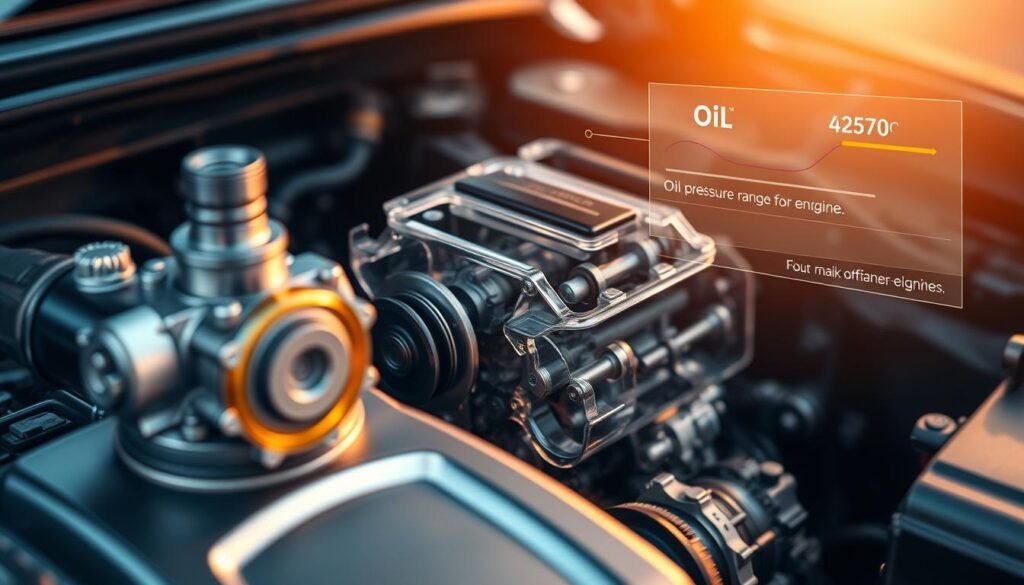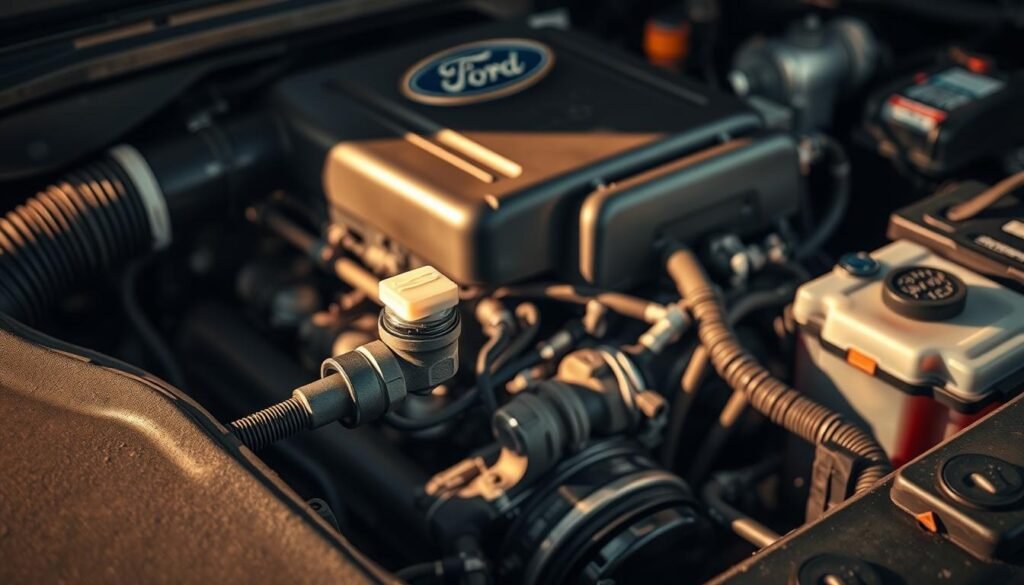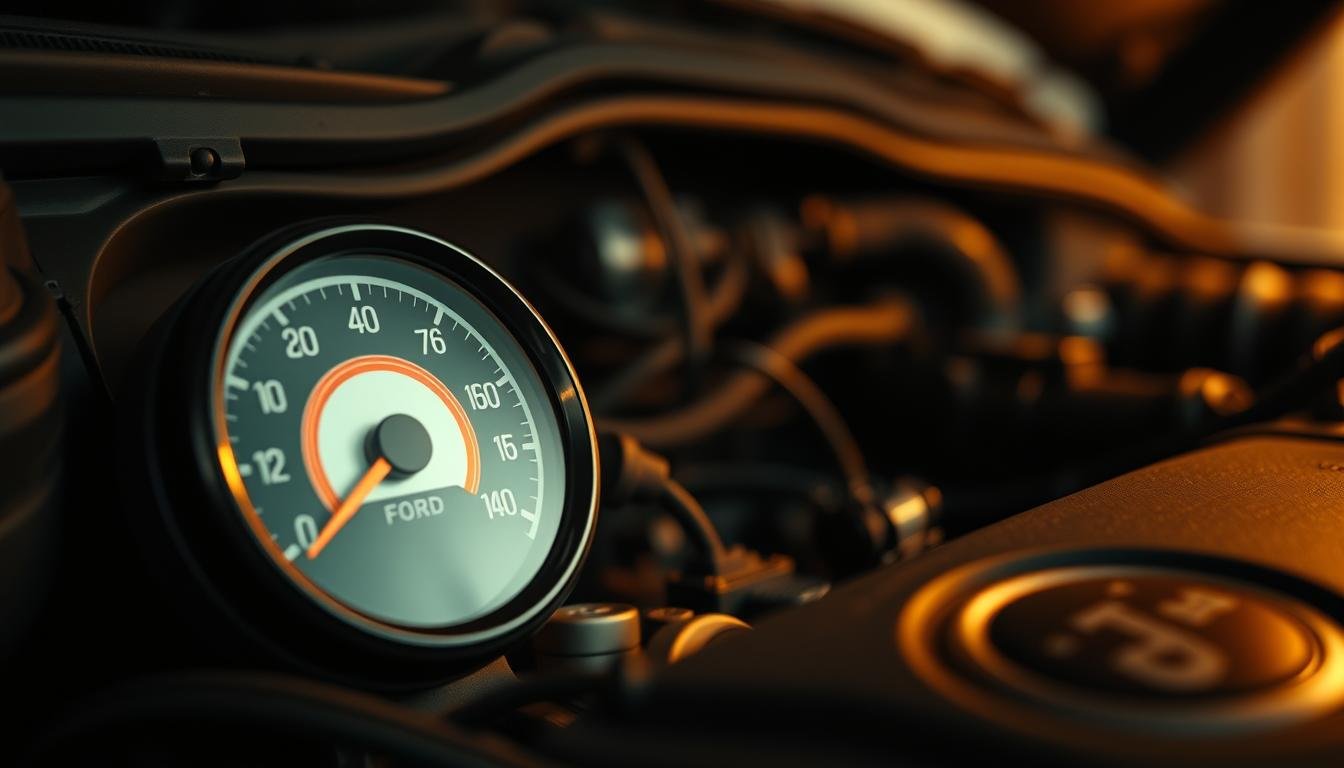Knowing What Is Low Engine Oil Pressure Ford? Urgent 7 Info
Low engine oil pressure is a big problem in Ford vehicles. It must be fixed quickly to avoid bad engine damage. Ford models like the Explorer and F-150 can face this issue.
If not handled soon, it can cost a lot in repairs. Look out for dashboard warnings and strange engine sounds to act fast.
We’ll look at why Ford vehicles might have low oil pressure, including issues like oil pump failures and leaks. You’ll find out how to keep an eye on oil pressure.
This ensures your engine is well-lubricated, cutting down friction. It also stops early damage to important engine parts.
By staying on top of oil pressure, your Ford will perform better and last longer. Next, we’ll get into detailed steps to manage low engine oil pressure for a smoothly running Ford.
What is Low Engine Oil Pressure?
Engine oil pressure is critical for your Ford’s parts to stay lubricated. This lubrication lets the engine run smoothly. Knowing about engine oil pressure can save you from costly repairs.
Importance of Engine Oil Pressure
It’s crucial to keep the engine oil pressure right. This avoids wear and tear, saving your engine from damage.
If the pressure drops, your Ford may face higher heat and faster wear. So, checking your oil pressure regularly is wise.
How Low Oil Pressure Affects Engine Health?
Too low oil pressure is bad news. It means parts like pistons could overheat and get damaged. Knowing the signs of low oil pressure is key to keep your vehicle running well.
Common Symptoms of Low Engine Oil Pressure
Keeping your Ford running well means watching for signs of low engine oil pressure. Several indicators can warn you of trouble before it harms your engine.
Dashboard Warning Light Indicators
The most direct sign is your dashboard’s oil pressure warning lights. These lights are crucial reminders to check your oil pressure.
If they turn on, it means your Ford has low oil pressure and you should look into it quickly.
Unusual Engine Noises and Performance Issues
You should also listen for odd engine sounds. Knocking or ticking noises can mean there’s a problem with oil pressure.
This situation points to poor lubrication when the engine is running. You might notice your car isn’t running as well or as efficiently as before.
These are signs of low oil pressure in your Ford. Act fast if you notice these issues to prevent further problems.

Why Oil Pressure Matters For Engine Health?
Your engine’s health is deeply linked to the right oil pressure. Keeping oil pressure proper ensures all engine parts are well-lubricated.
This not only cuts down friction but is key to stopping big engine problems caused by poor oil pressure.
Lubrication and Friction Reduction
Good oil pressure lessens friction, making engine parts run smoothly. If there’s not enough lubrication, parts wear out faster, lowering engine performance.
So, high oil pressure is critical to prevent engine harm early on.
Preventing Overheating and Engine Damage
Right oil pressure is crucial to stop engines from getting too hot. Engines without enough oil heat up fast, which can warp parts or cause total engine failure.
Knowing this helps you keep your vehicle in top shape for longer.

How To Recognize The Oil Pressure Warning Signs?
Learning the Ford oil pressure warning light is key to keeping your car running well. A light on the dashboard means you need to act fast.
Ford cars have an oil pressure gauge to show how the pressure is doing. Knowing what these signs mean helps keep your engine in good shape.
Learning The Warning Lights
The Ford oil pressure light tells you if there’s something wrong with how the oil moves in your car. It lights up for problems like oil leaks, low oil, or a bad oil pump.
Ignoring this can cause big damage to your engine. Always check your dashboard lights to stay on top of car care.
Monitoring Oil Pressure Gauge Readings
Having a broken oil pressure gauge can keep you from knowing your car’s oil pressure. In Ford cars, it’s crucial to watch this gauge when you’re driving.
A low reading means trouble and needs fast action. If the gauge isn’t right, get it checked or changed.

Getting to know the warning lights and keeping an eye on the oil pressure gauge are big steps to avoid expensive fixes and keep your engine running well.
Low Engine Oil Pressure Ford: Main Causes and Diagnostics
Low engine oil pressure in Ford vehicles happens for many reasons. It’s vital to know why to fix it right and keep your vehicle running well. Finding and fixing these problems fast is key to good maintenance.
Causes of Low Oil Pressure
Getting to the root of Ford’s low oil pressure issues is the first step. Some common problems are:
- Insufficient oil levels due to leaks
- Worn-out internal components such as bearings or oil pumps
- Clogged oil filters restricting oil flow
- Contaminated engine oil affecting viscosity
Diagnostic Steps For Identifying Issues
To pinpoint low oil pressure problems, follow a step-by-step guide. Here’s how to start solving these issues:
- Check the engine oil level using the dipstick.
- Inspect underneath the vehicle for leaks.
- Replace the oil filter if it appears dirty or clogged.
- Examine the oil pump for signs of wear or failure.
- Use diagnostic tools to evaluate engine performance and pressure readings.

Essential Maintenance Steps To Prevent Oil Pressure Issues
Routine maintenance is key to avoiding low oil pressure in your vehicle. By following certain practices, you can keep your engine healthy. This ensures your car runs well for a long time.
Regular Oil Change Intervals
It’s important to change your oil regularly to keep your engine running well. Ford suggests doing this every 7,500 miles. Fresh oil means your engine parts stay well-lubricated.
Choosing The Right Engine Oil Type
Using the right oil for your engine is critical. Check your owner’s manual for advice. The right oil type and viscosity keep your engine running smoothly and avoid oil pressure issues.
Importance of Oil Filter Replacement
Changing your oil filter often is a must to keep oil clean. When it’s clogged, oil flow drops, and oil pressure may fall.
Remember to replace the oil filter with every oil change to keep your engine getting clean oil.
| Maintenance Task | Frequency | Purpose |
|---|---|---|
| Regular Oil Change | Every 7,500 miles | Maintains effective lubrication and engine performance |
| Choosing the Right Engine Oil | As needed (per oil change) | Ensures optimal engine protection and efficiency |
| Oil Filter Replacement | With each oil change | Prevents clogs and maintains oil flow |
Dealing with A Faulty Oil Pressure Sensor
A bad oil pressure sensor can give wrong readings of your car’s oil pressure. This might make you worry for no reason. Knowing when your sensor is failing is key to keep your car running well.
If your car’s warning lights stay on or if the oil pressure changes a lot, it’s probably time to get a new Ford oil pressure sensor.
Signs Your Oil Pressure Sensor Needs Replacement
- Persistent dashboard warning lights despite adequate oil levels.
- Inconsistent oil pressure gauge readings that fluctuate erratically.
- Unusual engine noises, which could indicate underlying oil pressure sensor issues.
- Dropping oil levels without any visible leaks or consumption.
How To Replace The Oil Pressure Sensor?
Changing the oil pressure sensor is usually easy. Here are the steps to replace a Ford oil pressure sensor smoothly:
- Gather necessary tools: a new oil pressure sensor, wrenches, and a suitable oil catch pan.
- Locate the oil pressure sensor, typically situated near the engine block.
- Disconnect the electrical connector from the faulty oil pressure sensor.
- Remove the old sensor with a wrench, avoiding oil spills.
- Put a little oil on the new sensor’s threads before installing it.
- Reconnect the electrical connector, making sure it’s tight.
- Start the car and check for leaks near the new sensor.
Identifying and Fixing Common Oil Pressure Problems
Knowing about oil pressure issues helps keep your engine healthy. Low oil pressure mainly comes from a bad oil pump or oil leaks.
Spotting these problems early can save your engine from big trouble.
Signs of A Failing Oil Pump
You might hear more noise from the engine or see oil pressure change a lot. Warning lights could also mean there’s not enough oil. If you notice these signs, fix them fast to protect your engine.
Effects of Oil Leaks and Their Solutions
Oil can leak from different places like the oil pan or seals. Leaks lower the oil level, which is bad for your engine. Check your car often for oil leaks.
Quickly fixing leaks helps your engine work right. If you’re not sure where a leak is coming from, ask a pro for help.
How To Fix Low Oil Pressure in Ford Vehicles?
If your Ford shows low oil pressure, it’s a big deal for your engine. Acting fast can help avoid worse damage. Start with a few key steps to handle it right.
Steps to Address Low Oil Pressure Instantly
Here’s how to tackle low oil pressure quickly:
- Use the dipstick to check the oil. Refill if it’s too low.
- Change the oil filter if it’s clogged to improve oil flow.
- Search for any oil leaks under your car.
- Watch the oil pressure gauge to check if the issue is fixed.
- Keep an eye on warning lights; they may mean more troubleshooting is needed.
When To Seek Professional Assistance?
It’s important to know when to get help for low oil pressure. If problems linger after you’ve tried fixing it, a bad oil pump or sensor may be at fault.
A skilled mechanic can run a full check and spot any hidden problems, making sure your Ford stays in top shape.
Quick action on low oil pressure is key for your engine’s wellbeing and your car’s performance. Be proactive and stay informed for smooth driving.
Compromise The Impact of Using Incorrect Oil Types
Choosing the right engine oil is key for your car to run well and last longer. Using the wrong oil can hurt your car in different ways.
It could damage the engine and cause problems that could have been avoided.
Consequences of Mismatched Oil Specifications
Not following oil recommendations can lead to:
- Inadequate lubrication: This makes parts wear out faster and can cause them to fail early.
- Higher operating temperatures: The wrong oil might not cool parts well, which can overheat the engine.
- Damaged seals and gaskets: Some oils can damage seals, causing leaks.
- Increased engine deposits: Poor quality oil can create sludge, blocking oil flow.
Knowing Oil Standards as per Ford Guidelines
Ford sets oil standards to keep your vehicle running smoothly. Always look at your owner’s manual for the right oil type for your Ford.
This will tell you about the viscosity grades and certifications needed. Following Ford’s oil advice helps protect the engine, improve gas mileage, and make engine parts last longer.
- Enhance engine protection against wear and tear.
- Promote better fuel efficiency.
- Extend the lifespan of engine components.
Conclusion
It’s important to know about low engine oil pressure Ford to keep your car running well. Spotting the signs of low oil pressure early can save your engine from big problems.
Remember to change your oil on time and check the levels often to maintain good engine oil pressure.
Taking care of oil pressure issues right away helps your engine last longer and run better. If you keep having problems, it’s important to get help from a pro.
This way, you can make sure your car is fixed well. Knowing how to keep up engine oil pressure will protect your car for many years.
FAQs
Q: What are some common Ford low oil pressure symptoms?
A: A dashboard ‘low oil pressure’ light may turn on if there’s a problem. You might hear odd engine noises, like knocking. Your engine might not perform as well, either.
Q: What causes low engine oil pressure in Ford vehicles?
A: Low oil levels from leaks can cause this issue. Worn engine parts, a bad oil pump, or clogged oil filters are also common causes.
Q: How can I diagnose low oil pressure in my Ford?
A: First, check your oil level and look for leaks. A diagnostic tool can also help spot what’s wrong.
Q: What should I do if my Ford’s oil pressure warning light turns on?
A: Check your oil right away and fill it if it’s low. But if the light stays on, you’ll need a mechanic’s help to figure out the problem.
Q: How often should I perform oil changes to prevent low oil pressure?
A: Follow the oil change schedule Ford recommends, usually every 7,500 miles. You can also find this info in your user manual.
Q: How do I know if my oil pressure sensor is faulty?
A: Warning lights that won’t turn off even when oil levels are fine are a clue. So are strange oil pressure readings. Consider getting the sensor replaced if you see these signs.
Q: What are the steps to fix low oil pressure in Ford vehicles?
A: Make sure your oil level is good and change any clogged filters. Look for leaks as well. If trouble continues, a skilled technician should take a look.
Q: Can using the wrong engine oil affect oil pressure?
A: Yes, the wrong oil type can cause poor lubrication and more engine wear. This can mess up your engine’s performance and the oil pressure.







